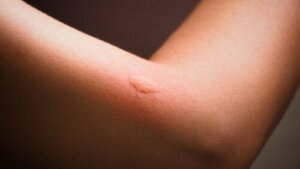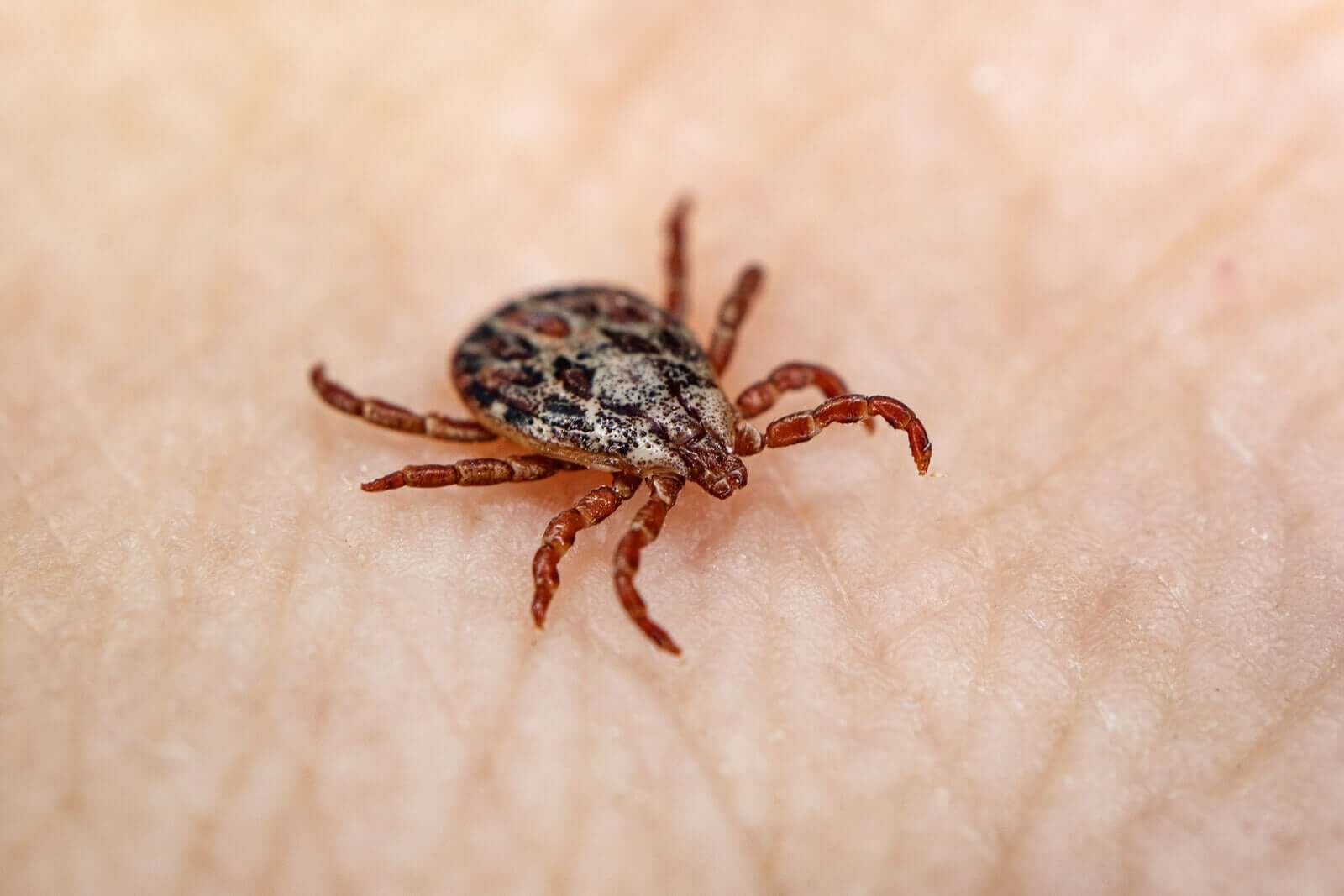Guide to Identifying Insect Bites in Children

Insect bites are very annoying for children, as they cause pain, itching, and allergic reactions to the venom that they inject into the skin.
Unfortunately, there are different species capable of causing these lesions and each leaves a characteristic imprint on the skin. Learning to recognize the causative agent from the appearance of the bite is very important to offer your child the best care. We’ll tell you how to do it.
The most common clinical manifestations of insect bites
Most bites tend to cause mild and manageable discomfort, but some can induce more severe and even fatal cases. Especially if the child has a history of severe allergies to the venom of the insect.
Although sometimes we can observe the insect during the attack, on other occasions, the signs and symptoms appear later. Among them, the following stand out:
- Redness or rash
- Swelling
- Pruritus (itching)
- Pain in the affected region
- Local heat and in nearby areas
- Tingling or numbness in the affected area

Warning signs in children after an insect bite
Some of the typical symptoms of a severe allergic reaction (or anaphylaxis) are as follows:
- Difficulty breathing
- Fever
- Muscle spasms
- Vomiting or nausea
- Edema in the throat and lips
- Loss of consciousness and confusion
In the presence of any of these manifestations, the most appropriate thing is to consult a doctor as soon as possible. Anaphylaxis is a medical emergency.
Even if the child feels sick or has flu-like symptoms in the days after the bite, it’s best to consult a doctor. This is important to rule out other diseases that could have been acquired through the insect.
The most frequent insect bites
The most frequent bites depend, to a great extent, on the place where you live or visit. The season of the year is also a factor to take into consideration. For example, the prevalence of injuries caused by bees, mosquitoes, and ants is higher during the summer.
Another important fact is that although insects can bite anywhere on the body, they most often do so in those areas of the skin that are exposed.
Next, we’re going to tell you the peculiarities of the injuries caused by different insects. Take note!
1. Mosquito bites
A mosquito bite manifests itself as a small, swollen, round bump that appears quickly after the attack. As the hours go by, this lesion becomes harder, redder, and very itchy.
In general, several hives may appear in the same area, as the child doesn’t feel when the mosquito bites them and the insect does so repeatedly. This is because mosquitoes have a very fine stinger to cause minimal trauma to the skin.
2. Red ant stings
The sting caused by fire ants (or “fire ants”) is considered a medical emergency, so urgent attention may be necessary.
Fire ants are small, reddish, or black, and very aggressive. The venom they inoculate produces a very sharp and painful sting. This appears in the form of a red dot with a central pustule that burns and itches a lot. In general, they last up to a week.
In some cases, the venom of these insects can cause a dangerous and serious allergic reaction, which manifests itself as generalized itching, marked swelling throughout the body, and difficulty in breathing.
Read also: Flea and spider bites in children
3. Tick bite
Tick bites can cause swelling and pain in the affected area. Also, they can cause a generalized rash, some blisters, and a burning sensation or shortness of breath.
In most cases, the tick remains attached to the surface of the skin for a long time, and hives rarely appear “in groups.”

4. Bee or wasp stings
One of the most common insect stings among children is caused by bees or wasps. The characteristic lesion of these insects is a reddening of the skin, with a lot of pain, edema, and itching in the area of the bite.
Bees can only sting once, as in doing so, they deposit their stinger on the skin. Where the needle is, a white spot even appears.
You may be interested: Allergy to bites in babies and children
5. Flea bites
Flea bites are generally seen “in groups” and usually affect the lower legs and feet. In most cases, they’re red and itchy bumps, which are surrounded by a red halo.
The symptoms of this bite appear immediately.
6. Bed bug bites
The characteristic bed bug lesion is a small rash with red, swollen areas with a dark red center. In general, itching responds to the allergic reaction caused by the insect venom inside the body.
According to a recent study, primary bed bug bite lesions can appear in a line, or “in clusters,” on bare body regions such as the feet, neck, or hands.
Why do reactions to stings occur?
The immune system responds to insect poisons after injecting them into the skin. This is what explains why swelling and redness occur in the area of the bite and sometimes at a distance.
Mild delayed reactions include pain and itching, but if the child is sensitive to the venom, a potentially fatal condition called anaphylactic shock can be triggered.

Insect bites in children and their prevention
The best medicine is prevention, so knowing how to identify and avoid insect bites is the best way to keep little ones healthy.
In general, most bites resolve on their own after several days of mild discomfort. Meanwhile, you should monitor the affected site to rule out and avoid an over-aggregated infection.
Insect bites are very annoying for children, as they cause pain, itching, and allergic reactions to the venom that they inject into the skin.
Unfortunately, there are different species capable of causing these lesions and each leaves a characteristic imprint on the skin. Learning to recognize the causative agent from the appearance of the bite is very important to offer your child the best care. We’ll tell you how to do it.
The most common clinical manifestations of insect bites
Most bites tend to cause mild and manageable discomfort, but some can induce more severe and even fatal cases. Especially if the child has a history of severe allergies to the venom of the insect.
Although sometimes we can observe the insect during the attack, on other occasions, the signs and symptoms appear later. Among them, the following stand out:
- Redness or rash
- Swelling
- Pruritus (itching)
- Pain in the affected region
- Local heat and in nearby areas
- Tingling or numbness in the affected area

Warning signs in children after an insect bite
Some of the typical symptoms of a severe allergic reaction (or anaphylaxis) are as follows:
- Difficulty breathing
- Fever
- Muscle spasms
- Vomiting or nausea
- Edema in the throat and lips
- Loss of consciousness and confusion
In the presence of any of these manifestations, the most appropriate thing is to consult a doctor as soon as possible. Anaphylaxis is a medical emergency.
Even if the child feels sick or has flu-like symptoms in the days after the bite, it’s best to consult a doctor. This is important to rule out other diseases that could have been acquired through the insect.
The most frequent insect bites
The most frequent bites depend, to a great extent, on the place where you live or visit. The season of the year is also a factor to take into consideration. For example, the prevalence of injuries caused by bees, mosquitoes, and ants is higher during the summer.
Another important fact is that although insects can bite anywhere on the body, they most often do so in those areas of the skin that are exposed.
Next, we’re going to tell you the peculiarities of the injuries caused by different insects. Take note!
1. Mosquito bites
A mosquito bite manifests itself as a small, swollen, round bump that appears quickly after the attack. As the hours go by, this lesion becomes harder, redder, and very itchy.
In general, several hives may appear in the same area, as the child doesn’t feel when the mosquito bites them and the insect does so repeatedly. This is because mosquitoes have a very fine stinger to cause minimal trauma to the skin.
2. Red ant stings
The sting caused by fire ants (or “fire ants”) is considered a medical emergency, so urgent attention may be necessary.
Fire ants are small, reddish, or black, and very aggressive. The venom they inoculate produces a very sharp and painful sting. This appears in the form of a red dot with a central pustule that burns and itches a lot. In general, they last up to a week.
In some cases, the venom of these insects can cause a dangerous and serious allergic reaction, which manifests itself as generalized itching, marked swelling throughout the body, and difficulty in breathing.
Read also: Flea and spider bites in children
3. Tick bite
Tick bites can cause swelling and pain in the affected area. Also, they can cause a generalized rash, some blisters, and a burning sensation or shortness of breath.
In most cases, the tick remains attached to the surface of the skin for a long time, and hives rarely appear “in groups.”

4. Bee or wasp stings
One of the most common insect stings among children is caused by bees or wasps. The characteristic lesion of these insects is a reddening of the skin, with a lot of pain, edema, and itching in the area of the bite.
Bees can only sting once, as in doing so, they deposit their stinger on the skin. Where the needle is, a white spot even appears.
You may be interested: Allergy to bites in babies and children
5. Flea bites
Flea bites are generally seen “in groups” and usually affect the lower legs and feet. In most cases, they’re red and itchy bumps, which are surrounded by a red halo.
The symptoms of this bite appear immediately.
6. Bed bug bites
The characteristic bed bug lesion is a small rash with red, swollen areas with a dark red center. In general, itching responds to the allergic reaction caused by the insect venom inside the body.
According to a recent study, primary bed bug bite lesions can appear in a line, or “in clusters,” on bare body regions such as the feet, neck, or hands.
Why do reactions to stings occur?
The immune system responds to insect poisons after injecting them into the skin. This is what explains why swelling and redness occur in the area of the bite and sometimes at a distance.
Mild delayed reactions include pain and itching, but if the child is sensitive to the venom, a potentially fatal condition called anaphylactic shock can be triggered.

Insect bites in children and their prevention
The best medicine is prevention, so knowing how to identify and avoid insect bites is the best way to keep little ones healthy.
In general, most bites resolve on their own after several days of mild discomfort. Meanwhile, you should monitor the affected site to rule out and avoid an over-aggregated infection.
All cited sources were thoroughly reviewed by our team to ensure their quality, reliability, currency, and validity. The bibliography of this article was considered reliable and of academic or scientific accuracy.
- Williams LA, Allen LV Jr. Treatment and prevention of insect bites: mosquitoes. Int J Pharm Compd. 2012 May-Jun;16(3):210-8. PMID: 23050298. Disponible en: https://pubmed.ncbi.nlm.nih.gov/29261949/
- Powers J, McDowell RH. Picaduras de insectos. [Actualizado el 11 de agosto de 2021]. En: StatPearls [Internet]. Treasure Island (FL): StatPearls Publishing; 2021 enero-. Disponible en: https://www.ncbi.nlm.nih.gov/books/NBK537235/
- Kruse B, Anderson J, Simon LV. Fire Ant Bites. 2021 Aug 11. In: StatPearls [Internet]. Treasure Island (FL): StatPearls Publishing; 2021 Jan–. PMID: 29261949. Disponible en: https://pubmed.ncbi.nlm.nih.gov/29261949/
This text is provided for informational purposes only and does not replace consultation with a professional. If in doubt, consult your specialist.








